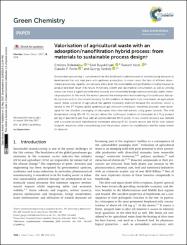| dc.contributor.author | Didaskalou, Christos | |
| dc.contributor.author | Büyüktiryaki, Sibel | |
| dc.contributor.author | Keçili, Rüstem | |
| dc.contributor.author | Fonte, Claudio P. | |
| dc.contributor.author | Szekely, Gyorgy | |
| dc.date.accessioned | 2019-10-23T17:56:20Z | |
| dc.date.available | 2019-10-23T17:56:20Z | |
| dc.date.issued | 2017 | |
| dc.identifier.issn | 1463-9262 | |
| dc.identifier.issn | 1463-9270 | |
| dc.identifier.uri | https://dx.doi.org/10.1039/c7gc00912g | |
| dc.identifier.uri | https://hdl.handle.net/11421/22922 | |
| dc.description | WOS: 000404609200025 | en_US |
| dc.description.abstract | Downstream processing is considered to be the bottleneck in pharmaceutical manufacturing because its development has not kept pace with upstream production. In some cases, the lack of efficient downstream processing capacity can seriously affect both the sustainability and profitability of a pharmaceutical product and even result in its failure. Minimising solvent and raw material consumption, as well as utilising waste, can make a significant difference towards environmentally benign and economically viable chemical production. In this work, the authors present the development and modelling of a continuous adsorption process with in situ solvent recovery for the isolation of oleuropein from olive leaves, an agricultural waste. Waste utilisation in agriculture has gained increasing attention because this economic sector is ranked as the 2nd highest global greenhouse gas emission contributor. Imprinted polymers were developed for the selective scavenging of oleuropein from olive leaf extracts using green solvents. The mild temperature-swing (25-43 degrees C) process allows the continuous isolation of oleuropein at 1.75 g product per kg of adsorbent per hour with an unprecedented 99.7% purity. In situ solvent recovery was realized with a solvent-resistant nanofiltration membrane allowing 97.5% solvent recycle and 44.5% total carbon footprint reduction, while concentrating both the product stream for crystallisation and the waste stream for disposal. | en_US |
| dc.description.sponsorship | Engineering and Physical Sciences Research Council [BioProNET BIV Nov15 Szekely]; Biotechnology and Biological Sciences Research Council [BB/L013770/1]; Royal Academy of Engineering's Newton Research Collaboration Programme [NRCP1516/1/41] | en_US |
| dc.description.sponsorship | The authors are grateful to Dr Thanos Didaskalou and Gazi Buyuktiryaki for the leaves from their olive groves in Thessaloniki (Greece) and Mugla (Turkey), respectively. Useful discussions and analytical insights provided by Dr Jozsef Kupai from the Technical University of Budapest are greatly acknowledged. This work was supported by the Engineering and Physical Sciences Research Council [BioProNET BIV Nov15 Szekely]; the Biotechnology and Biological Sciences Research Council [BioProNET BIV Nov15 Szekely, BB/L013770/1]; and the Royal Academy of Engineering's Newton Research Collaboration Programme [NRCP1516/1/41]. | en_US |
| dc.language.iso | eng | en_US |
| dc.publisher | Royal Soc Chemistry | en_US |
| dc.relation.isversionof | 10.1039/c7gc00912g | en_US |
| dc.rights | info:eu-repo/semantics/openAccess | en_US |
| dc.title | Valorisation of agricultural waste with an adsorption/nanofiltration hybrid process: from materials to sustainable process design | en_US |
| dc.type | article | en_US |
| dc.relation.journal | Green Chemistry | en_US |
| dc.contributor.department | Anadolu Üniversitesi, Yunus Emre Sağlık Hizmetleri Meslek Yüksekokulu | en_US |
| dc.identifier.volume | 19 | en_US |
| dc.identifier.issue | 13 | en_US |
| dc.identifier.startpage | 3116 | en_US |
| dc.identifier.endpage | 3125 | en_US |
| dc.relation.publicationcategory | Makale - Uluslararası Hakemli Dergi - Kurum Öğretim Elemanı | en_US] |
| dc.contributor.institutionauthor | Büyüktiryaki, Sibel | |
| dc.contributor.institutionauthor | Keçili, Rüstem | |


















